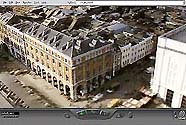Wouldn't it be fantastic if, before the
local council built a set of new buildings in your area, you could look in to the future
and see how it was going to affect you?Or, better still, you could move about the new
development, ask questions about the project and then make your comments about it.
What started off as an Internet project bringing low bandwidth virtual reality to a
home PC could soon allow users to be involved in construction and planning issues in their
local area.
It's the brainchild of PhD student Andy Smith, who sits behind his computer day after
day building virtual worlds. He is part of CASA (Centre for Advanced Spacial Analysis) at
University College London which has announced a number of projects that could make those
virtual visions reality.
Virtual London and the Shared Architecture initiatives are two projects that will
involve the online community in developing realistic virtual worlds that do not have to be
viewed on a high specification computer using special architectural software.
By using off the shelf software, which the team at CASA has been able to modify,
photographs can be used in the online virtual community browser called Active Worlds
(www.activeworlds.com) where Andy Smith has created the CVDS, an online virtual world
where anyone can learn how to build.
Smith explained: "The projects are part of the Designing Better Cities initiative
which has received funding from the Engineering and Physical Sciences Research Council.
"This is the first time that realistic images have been used in this way and it
opens up a lot of opportunity to be used in the public domain.
"The public will be able to access real projects in their local areas that affect
them, put across their opinion and even make changes that could benefit everyone when
developing a real life community.
"We are asking users of CVDS to send in photographs of their homes so we can place
them in the virtual world, creating a unique opportunity to see your house in the virtual
3D world."
People can e-mail or post pictures of their home to Smith who will then model them
using the adapted software and place it within CVDS, as well as putting them on CASA's web
site in VRML, another type of program that allows users to walk around a 3D model (the
COSMO vrml player will be needed).
Smith added: "What we are aiming for is to have a virtual London within CVDS and
then for all the users homes to be in the 'suburbs'.
"Virtual Cities have been talked about for a long time from virtual Chicago,
virtual New York to Virtual London.
"None of them have really been true digital cities existing on the low bandwidth
environment of the Internet, but we are developing a virtual London which will be the
first true multi-user real world city.
"People will be able to see Buckingham Palace, Trafalgar Square and Covent Garden
and have a virtual tour guide explain aspects of the city to them.
"Once it develops we expect third parties to get involved as the Shared
Architecture shows the quality on the model
"Virtual London will be using a variety of media to provide three dimensional
models of London buildings hotlinked to geographical and spatial information."
CASA is currently looking in to approaching further bodies to get involve with the
project including local councils, businesses and tourist authorities.
The original CVDS world began life as a 30-day trial, but became so popular that it was
extended, with competitions for the best designed building.
Users of the world are allowed to build what they want using special modelling codes
that can produce all manner of shapes and textured surfaces and led to the development of
a dedicated community of users, including vandals.
The world has now been extended for a year, with many of its original 3D enthusiasts
being joined by newer members.
Active Worlds itself recently floated on the American stock market and now even
features a virtual shopping mall where you can really buy goods.
Smith said: "If we model the real world in a shared virtual space, as we are now
able, we can shape developments and view potential developments in the virtual world
before a brick is laid in the real world.
"This is now in the hands of the public not just building professionals using high
powered CAD workstations. Public involvement is the key."
The group is also in discussions for another virtual project, which will use similar
techniques, with the Natural History Museum to place a virtual version of the museum with
Active Worlds.
There is also discussions with Hackney Borough Council to add the 3D elements to its
Hackney Building Exploratory, which is hoped will expose more people to the planning going
on in a local community.
Smith summed up: "We have just made a major step forward towards the first true
multi user planning/development system.
"Without too much like hype, which it is not, this is a first glimpse of the
future for planning and construction."





